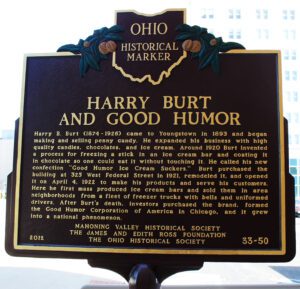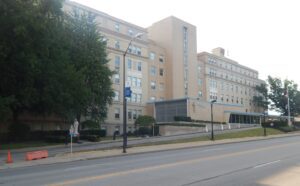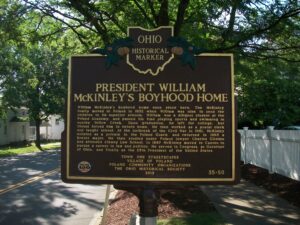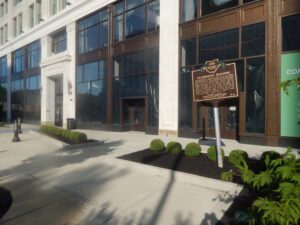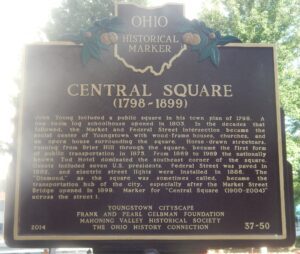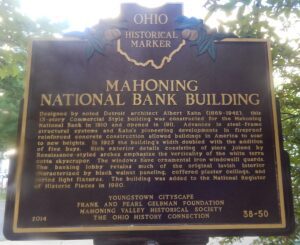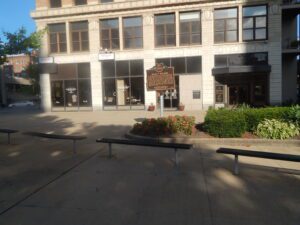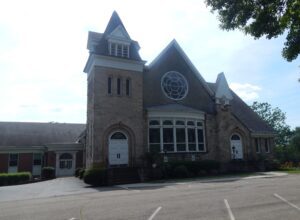, OH
Harry B. Burt (1874-1926) came to Youngstown in 1893 and began making and selling penny candy. He expanded his business with high quality candies, chocolates, and ice cream. Around 1920 Burt invented a process for freezing a stick in an ice cream bar and coating it in chocolate so one could eat it without touching it. He called his new confection “Good Humor Ice Cream Suckers.” Burt purchased the building at 325 West Federal Street in 1921, remodeled it, and opened it on April 4, 1922 to make his products and serve his customers. Here he first mass produced ice cream bars and sold them in area neighborhoods from a fleet of freezer trucks with bells and uniformed drivers. After Burt’s death, investors purchased the brand, formed the Good Humor Corporation of America in Chicago, and it grew into a national phenomenon.
, OH
The Sisters of the Humility Mary, who came here from France in 1864, opened St. Elizabeth Hospital on this site in the former Fitch House on December 8, 1911. St. Elizabeth Hospital has cared for all, regardless of ability to pay, and devoted itself to helping poor and underserved populations. On December 8, 2011, what is now St. Elizabeth Health Center celebrated its centennial and the evolution of St. Elizabeth Hospital into Humility of Mary Health Partners. The century-old mission of the Sisters continues to guide the institution into the 21st century.
, OH
William McKinley’s boyhood home once stood here. The McKinley family moved to Poland in 1852 when William was nine to send the children to its superior schools. William was a diligent student at the Poland Academy, and passed his time playing sports and swimming in nearby Yellow Creek. Upon graduation, he left for college, but illness forced him to return home. He then worked as a postal clerk and taught school. At the outbreak of the Civil War in 1861, McKinley enlisted as a private in the Poland Guard, and returned in 1865 a brevet major. He then studied under Poland lawyer Charles Glidden and attended Albany Law School. In 1867 McKinley moved to Canton to pursue a career in law and politics. He served in Congress, as Governor of Ohio, and finally as the 25th President of the United States.
, OH
Steel-frame skyscrapers and retail buildings replaced wood-frame residences as the downtown evolved into a commercial district. A small public library branch occupied the north side of the square from 1923 to 1954. The Keith-Albee Theater (later the Palace) in the northeast corner of the square from 1926 to 1964, featured vaudeville performances and movies. Streetcar tracks around the square were removed for scrap during World War II. With expansion of suburban shopping malls, downtown theaters and department stores gradually closed. In 1973-74 Central Square was converted to a pedestrian Federal Plaza by closing off traffic on Federal Street one block east and west of Market Street. Central Square reopened in 2004 with a new traffic pattern, planting beds, and street furniture. Marker for “Central Square (1798-1899)” across the street.
, OH
John Young included a public square in his town plan of 1798. A one-room log schoolhouse opened in 1803. In the decades that followed, the Market and Federal Street intersection became the social center of Youngstown with wood-frame houses, churches, and an opera house surrounding the square. Horse-drawn streetcars, running from Brier Hill through the square, became the first form of public transportation in 1875. From 1869 to 1969 the nationally known Tod Hotel dominated the southeast corner of the square. Guests included seven U.S. presidents. Federal Street was paved in 1882, and electric street lights were installed in 1886. The “Diamond,” as the square was sometimes called, became the transportation hub of the city, especially after the Market Street Bridge opened in 1899. Marker for “Central Square (1900-2004)” across the street.
, OH
Designed by noted Detroit architect Albert Kahn (1869-1942), this 13-story Commercial Style building was contructed for the Mahoning National Bank in 1910 and opened in 1911. Advances in steel-frame structural systems and Kahn’s pioneering developments in fireproof reinforced concrete construction allowed buildings in America to soar to new heights. In 1925 the building’s width doubled with the addition of five bays. Rich exterior details consisting of piers joined by Renaissance-styled arches emphasize the verticality of the white terra cotta skyscraper. The windows have ornamental iron windowsill guards. The banking lobby retains much of the original lavish interior characterized by black walnut paneling, coffered plaster ceilings, and period light fixtures. The building was added to the National Register of Historic Places in 1980.
, OH
The figure atop the Soldiers’ Monument has looked over Youngstown’s Central Square since 1870. Ohio Governor David Tod began campaigning for a monument for Youngstown’s fallen soldiers even before the Civil War ended. The community raised $15,000, and the cornerstone was laid in 1868. The memorial was completed and dedicated on July 4, 1870, with Governor Rutherford B. Hayes and Congressman James A. Garfield, both future U.S. presidents, attending the ceremony. Four cannons procured by Garfield formerly surrounded the monument. In 1951 the figure on the pedestal was accidentally damaged. A new statue of Carrara marble was commissioned, sculpted in Italy, and installed in 1955. The Bertolini Bros., a local marble firm, donated the new figure, which as patterned after the original, as their gift to the city.
, OH
In 1798, Judge Turhand Kirtland came to Township 1, Range 1 as an agent of the Connecticut Land Company. In 1804, Kirtland donated the Village Green and the graveyard adjoining the church to the residents of Poland. On the Green, the settlers built a log meetinghouse and school. Prior to 1812, the local militia drilled here and, in 1861, young men trained here before leaving to fight in the Civil War. The graveyard contains some 450 graves of early families of Poland, including settlers such as Kirtland, Fowler, Walker, Morse, Arrel, Adair, Lee, McCombs, and Truesdale. Among those buried here are thirteen Revolutionary War veterans, thirteen veterans of the War of 1812, and ten men who fought in the Civil War. In 1862, Samuel K. Hine provided in his will for the maintenance of both the Graveyard and the Green.


